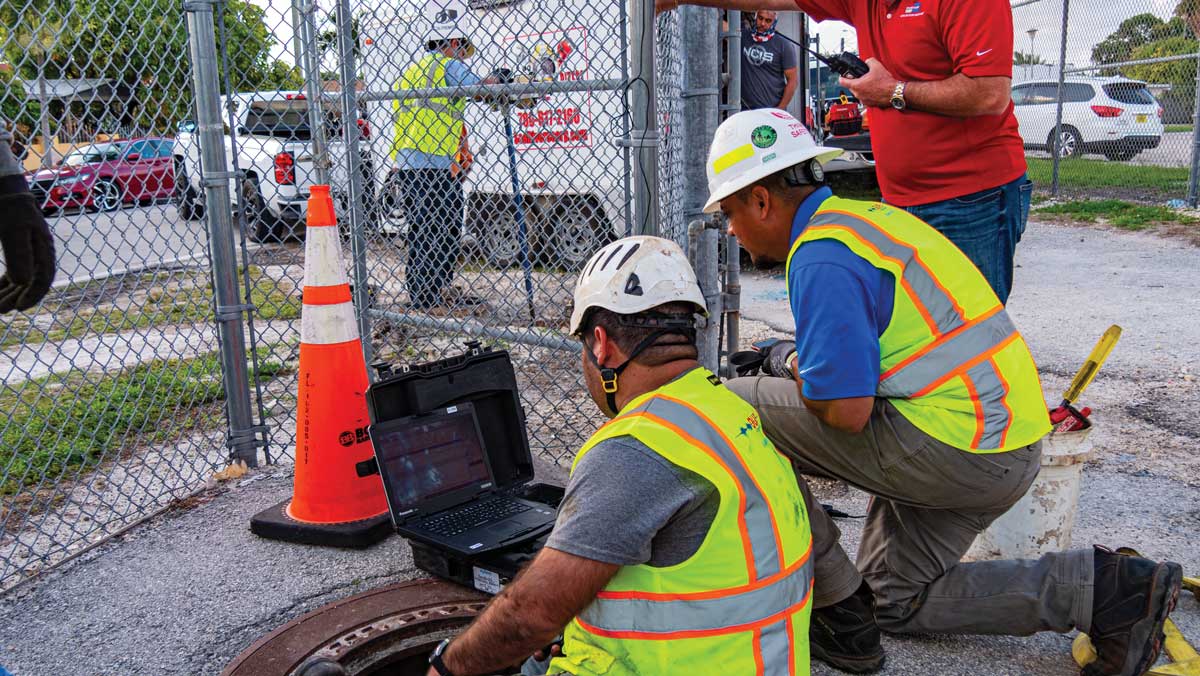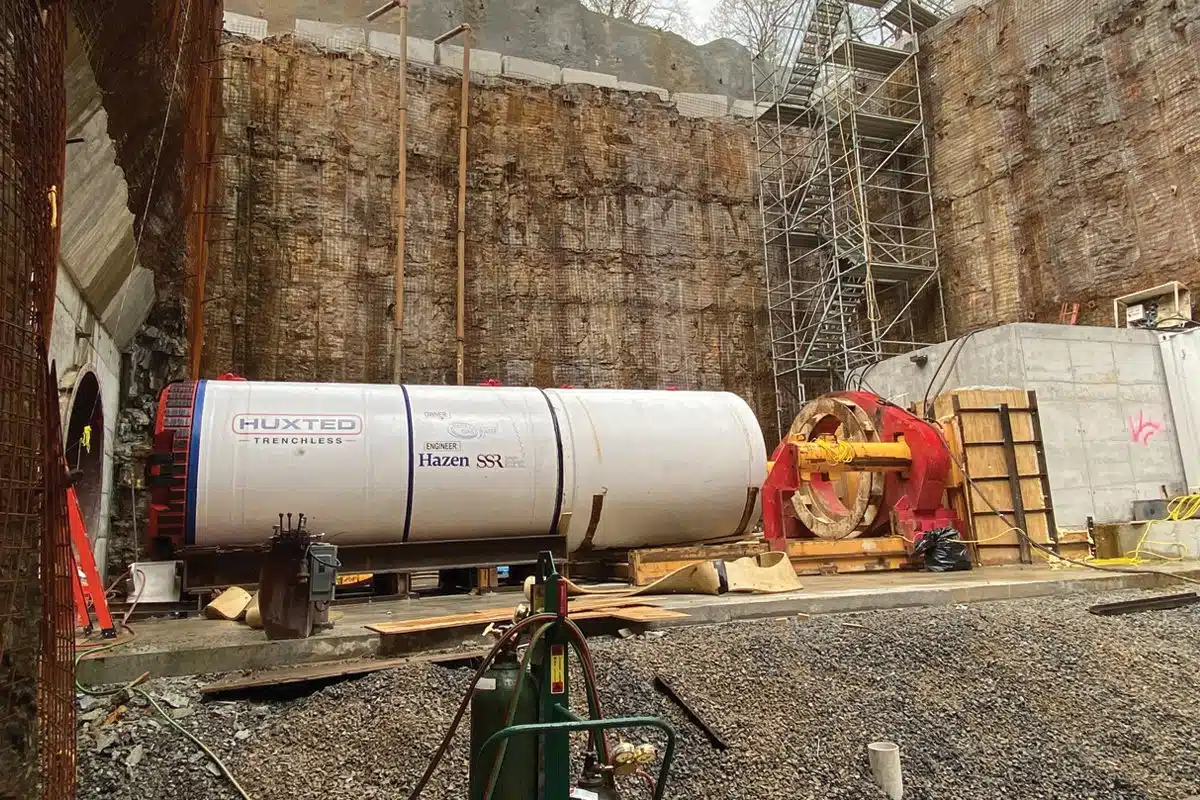
Reactive to Proactive: How Miami-Dade’s Condition Assessment Program Keeps the Water Flowing
Miami-Dade County has one of the largest water and sewer utilities in the United States. So, when something catastrophic happens, the eyes of the industry are drinking in every detail of how they react and solve the issue.
In 2010, Miami-Dade experienced a catastrophic failure of a 54-in. prestressed concrete cylinder pipe (PCCP) water transmission main. The aftermath of this failure resulted in the utility — which is the largest in the southeastern United States — implementing and maintaining one of the top condition assessment programs in the country to mitigate such an occurrence from happening again.
Since the program’s inception and aggressive initial pipe assessment, the department has recorded a significant decrease in distress rates — from the original 17 percent first documented in March 2010 to a department low of less than 4 percent today. Additionally, the department’s pipe rehabilitation rate has been reduced from more than 40 pipes a year between 2010-2015 to less than 10 pipes a year today.
“I feel the biggest compliment you can give a condition assessment program is that it is successful at preventing failures and ours has accomplished that,” says Lazaro Cabrera, director of water and sewer operations of the water transmission and distribution division of Miami-Dade Water and Sewer. “Moreover, we have a greater understanding of our system’s vulnerabilities today than we did when we started.”
Through its ongoing condition assessment actions — a critical component of Miami-Dade’s operations & maintenance program — the utility has rehabilitated or replaced 335 PCCP pipes before they failed and have added more than five miles of parallel mains to increase resiliency.

Program Impetus
The Miami-Dade Water and Sewer Department services 489,536 retail customers and operates and maintains more than 8,700 miles of water pipes, including 150 miles of PCCP. At approximately 50 years of age, the PCCP network was nowhere near its 70- to 80-year lifespan when the PCCP failure occurred.
Miami-Dade’s water system has more than 8,700 miles of pipes ranging from 2- to 96-in. mains. Most of the distribution system is ductile iron pipe, PVC, cement and cast iron and ranges between 2 and 16 in. The transmission mains are generally ductile iron pipe, cast iron and concrete. Approximately half of the total system is less than 40 years old. Miami-Dade operates with an average system pressure of less than 70 psi, which helps minimize pressure stress on pipes. To protect the system against Miami-Dade’s high-water table and corrosive soils, the utility has adopted HDPE and PVC since they are more resistant to corrosion, Cabrera explains.
There had been concern industrywide about the quality of PCCP mains that had Class IV reinforcing wire/rebar after some high-profile main failures in the mid-2000s. In particular, the failure of the class IV wires/rebars that strengthen the pipe. Miami-Dade was already laying the groundwork for a condition assessment program of its water and sewer network, working with Pure Technologies, before the catastrophic failure of that 54-in. PCCP water main.

“But when that failure happened, it sent everything into overdrive for us,” says Cabrera, noting that the failure also put the utility in the spotlight.
While still assessing the damage from the failed pipe, Pure Technologies technicians were onsite to conduct an emergency one-mile long, manned inspection on the pipe, using electromagnetic tools. The data collected from that single-section of pipe was alarming. “The data we got back was concerning because the one-mile inspection revealed that that one mile was showing 17 percent distress, meaning that 17 percent of the pipes in that one mile were showing signs of deterioration and wire breaks,” Cabrera says.
Those results merited an inspection of the entire PCCP pipe network. Results of that inspection showed that 10 percent of the entire network showed signs of hydrogen embrittlement, wire breaks and other forms of deterioration. That data was sent to a third party for further review and the results were confirmed.
“[The results] were eye-opening, not just for us but for the entire industry, as well,” Cabrera notes. “We’re the fifth largest system in the country and we’re having this issue. We sort of became the canary in the mine, if you will, for the rest of the country and really kicked off everybody looking inward at their own system, asking ‘Can this happen to us?’”

How Miami-Dade Proceeded
Following the results of the initial one-mile inspection, Miami-Dade went to work to develop a comprehensive condition assessment plan for the entire PCCP network, creating 18 pipe inspection routes with route 1 being the lowest grade (the 54-in. transmission main), based on established criteria. Using Pure Technologies’ inspection tools, the utility began the arduous task of inspecting each route over the next two and a half years to document, assess and treat the condition of the pipes. This was finished in 2012.
Once the entire water PCCP inventory was inspected and analyzed, Miami-Dade got to work prioritizing which pipes showed the highest potential for failure and then addressed them via rehabilitation or replacement. Three routes in particular — route 1, route 3 and route 4 — showed higher rates of distress than the rest of the inventory. These routes needed regular inspection to stay ahead of any potential issues. Miami-Dade weighed their options as how to address these pipes.
“We realized that we are going to need to use [Pure Technologies’] Pipe Diver for these pipes on a yearly basis or we could install a permanent monitoring system that would look after those routes for us,” Cabrera says.
Miami-Dade chose to install a permanent acoustic fiber-optic cable that runs down the interior floor of the pipes along these three routes. This cable is connected to a monitor that feeds data via a cellular network that Pure Technologies reviews. “They are monitoring these pipes and we get alerts any time a single wire breaks, what pipe segment it is and the approximate location within the pipe that sound is heard where a potential failure can occur,” Cabrera explains. “Based on that, these three routes are monitored 365 days a year, 24/7.”
Each time an inspection is conducted, Miami-Dade gets a report and included with the data are recommendations as to when to inspect that pipe next. On average, the utility inspects 15 to 20 miles of pipe each year. Since the inception of the program in 2010, 335 pipe sections have either been rehabilitated or replaced, with 210 of those sections found in route 1.
An example as to how well the condition assessment program is working, Cabrera reflects back to early in the process. He says after route 4 was inspected, which is its 48-in. transmission main, Miami-Dade received a report that a pipe section of that route could potentially fail. While prepping the appropriate action take, the pipe did in fact fail. But, unlike that initial catastrophic failure in 2010, Miami-Dade was prepared.
“So, we have our second catastrophic break but with this one, we were notified ahead of time,” Cabrera says. “This also solidified if there any doubters [to the steps they were taking], there weren’t any after route 4.”

Program Results
Now more than 10 years into the condition assessment program, Cabrera describes the results and data collected as game-changing when it comes the operation and maintenance of the PCCP network — changing the mindset from reactive to proactive.
Cabrera shares Miami-Dade’s experiences with PCCP and subsequent condition assessment strategies with other utilities, offering them insight into how to go about establishing a program to fit their needs and what they need to know before embarking on such a journey.
Among the steps he says utilities/cities need to take before crossing into condition assessment are: 1) find the inspection technology that fits their specific system and needs; and 2) glean as much knowledge about your system and document it.
“We can no longer rely on the institutional memory of our employees. There is a lot of turnover and you can’t rely on someone being here for 40 years. You need to have an incredible grasp of your inventory and system in order to do this successfully,” Cabrera says. “Ninety percent of [instituting a condition assessment program] is going to be planning.”
Sharon M. Bueno is the editor of Trenchless Technology.




